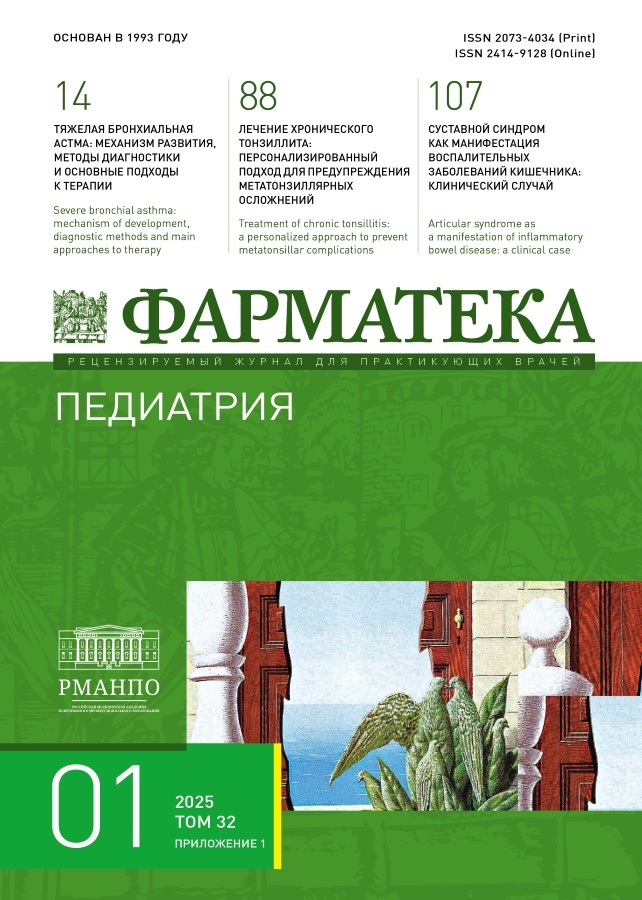Редкое заболевание костной системы у новорожденного ребенка
- Авторы: Габитова Н.Х.1, Черезова И.Н.1,2
-
Учреждения:
- Казанский государственный медицинский университет
- Республиканская клиническая больница МЗ РТ
- Выпуск: Том 32, № S (2025)
- Страницы: 113-116
- Раздел: Клинический разбор
- Статья опубликована: 18.07.2025
- URL: https://journals.eco-vector.com/2073-4034/article/view/687889
- DOI: https://doi.org/10.18565/pharmateca.2025.1-s1.113-116
- ID: 687889
Цитировать
Полный текст
Аннотация
Врожденные пороки костей, суставов и мышц могут быть проявлением генетических синдромов, при которых врожденные пороки распространяются не только на кости, суставы и мышцы, а также и на другие органы и системы. Синдром Брука – аутосомно-рецессивное заболевание с множественными контрактурами суставов и хрупкостью костей. Заболевание связывают с патогенными мутациями генов FKBP10 и PLOD2, картированных в 17 и 3 хромосоме соответственно. Набор генов PLOD2 и FKBP10 действует во время созревания проколлагена 1 типа и способствует молекулярной стабильности костной ткани. Мутации в генах PLOD2 и FKBP10 приводят к неправильной сборке костного матрикса и аномальным посттрансляционным модификациям коллагена 1 типа, что определяет патогенез болезни хрупкой кости. В статье представлен случай редкого заболевания с повышенной ломкостью костей, множественными врожденными контрактурами и врожденным пороком сердца, генетически идентифицированный как синдром Брука 1 типа.
Ключевые слова
Полный текст
Об авторах
Наиля Хусаиновна Габитова
Казанский государственный медицинский университет
Автор, ответственный за переписку.
Email: Borismk1@rambler.ru
ORCID iD: 0000-0002-8375-0565
кандидат медицинских наук, доцент кафедры госпитальной педиатрии
Россия, КазаньИ. Н. Черезова
Казанский государственный медицинский университет; Республиканская клиническая больница МЗ РТ
Email: Borismk1@rambler.ru
ORCID iD: 0000-0001-8961-0996
кандидат медицинских наук, доцент кафедры госпитальной педиатрии
Россия, Казань; КазаньСписок литературы
- Трофимова С.И., Коченова Е.А., Агранович О.Е. и др. Фенотипическая вариабельность у детей с синдромом Брука 2 типа: клинические наблюдения. Ортопедия, травматология и восстановительная хирургия детского возраста. 2023;11(4): 537–545. [Trofimova S.I., Kochenova E.A., Agranovich O.E., et al. Phenotypic variability in children with Brooke’s syndrome type 2: clinical observations. Pediatric Traumatology, Orthopaedics and Reconstructive Surgery. 2023;11(4):537–545. (In Russ.)]. doi: https://dx.doi.org/10.17816/PTORS569365
- Dayasiri K., Jayaweera H. Arthrogryposis multiplex congenita in a child with congenital fractures: a case report. J Med Case Rep. 2022;16(1):376. doi: https://dx.doi.org/10.1186/s13256-022-03587-1
- Вruck A. Ueber eine seltene form von Erkrankung der Knochen und Gelenke. Dtsch Med Wschr. 1897;23:152–155. doi: https://dx.doi.org/10.1055/s-0029-1204900
- Gistelinck C., Weis M., Rai J., et al. Abnormal bone collagen cross-linking in osteogenesis imperfecta/bruck syndrome caused by compound heterozygous plod2 mutations. JBMR Plus. 2021;5(3):e10454. doi: https://dx.doi.org/10.1002/jbm4.10454
- Kelley B.P., Malfait F., Bonafe L., et al. Mutations in FKBP10 cause recessive osteogenesis imperfecta and Bruck syndrome. J Bone Miner Res. 2011;26:666–672. doi: 10.1002/jbmr.250.
- Otaify G.A., Abdel-Hamid M.S., Hassib N.F., et al. Bruck syndrome in 13 new patients: Identification of five novel FKBP10 and PLOD2 variants and further expansion of the phenotypic spectrum. Am J Med Genet A. 2022;188(6):1815–1825. doi: https://dx.doi.org/10.1002/ajmg.a.62718
- Tan Z., Shek H.T., Chen P., et al. Clinical features and molecular characterization of Chinese patients with FKBP10 variants. Mol Genet Genomic Med. 2023;11(4):e2122. doi: https://dx.doi.org/10.1002/mgg3.2122
- Essawi O.H., Tapaneeyaphan P., Symoens S., et al. New insights on the clinical variability of FKBP10 mutations. Eur J Medical Genetics. 2020;63(9):103980. doi: https://dx.doi.org/10.1016/j.ejmg.2020.103980
- Litman C.D., Rajagopal A., Homan E.P., et al. Connective tissue changes in Fkbp10 - /- mice. Hum Mol Genet. 2014;23(18):4822–4831. doi: https://dx.doi.org/10.1093/hmg/ddu197
- Duran I., Martin J.H., Weis M.A., et al. A chaperone complex formed by HSP47, FKBP65, and BiP modulates telopeptide lysyl hydroxylation of type I procollagen. J Bone Miner Res. 2017;32(6):1309–1319. doi: https://dx.doi.org/10.1002/jbmr.3095
- Shang L., Shi W., Xu Y., et al. A novel compound heterozygous variation in the FKBP10 gene causes Bruck syndrome without congenital contractures: a case report. Heliyon. 2024;10(7):e28680. doi: https://dx.doi.org/10.1016/j.heliyon.2024. e28680
- Terajima M., Taga Y., Nakamura T., et al. Lysyl hydroxylase 2 mediated collagen post-translational modifications and functional outcomes. Sci Rep. 2022;12(1):14256. doi: https://dx.doi.org/10.1038/s41598-022-18165-0
- Saito T., Terajima M., Taga Y., et al. Decrease of lysyl hydroxylase 2 activity causes abnormal collagen molecular phenotypes, defective mineralization and compromised mechanical properties of bone. Bone. 2022;154:116242. doi: https://dx.doi.org/10.1016/j.bone.2021. 116242
- Mumm S., Gottesman G.S., Wenkert D., et al. Bruck syndrome 2 variant lacking congenital contractures and involving a novel compound heterozygous PLOD2 mutation. Bone. 2020;130:115047. doi: https://dx.doi.org/10.1016/j.bone.2019.115047
- Sandy J.L., Perez D., Goh S., et al. Expanding the phenotype of Bruck syndrome: Severe limb deformity, arthrogryposis, congenital cardiac disease and pulmonary hemorrhage. Am J Med Genet A. 2023; 191(1):265–270. doi: https://dx.doi.org/10.1002/ajmg.a.63007
- Тran C.T., Smet M.E., Forsey J., et al. Bruck syndrome: beyond the obvious. Fetal Diagn Ther. 2022;49(11–12):479–485. doi: https://dx.doi.org/10.1159/000527594











